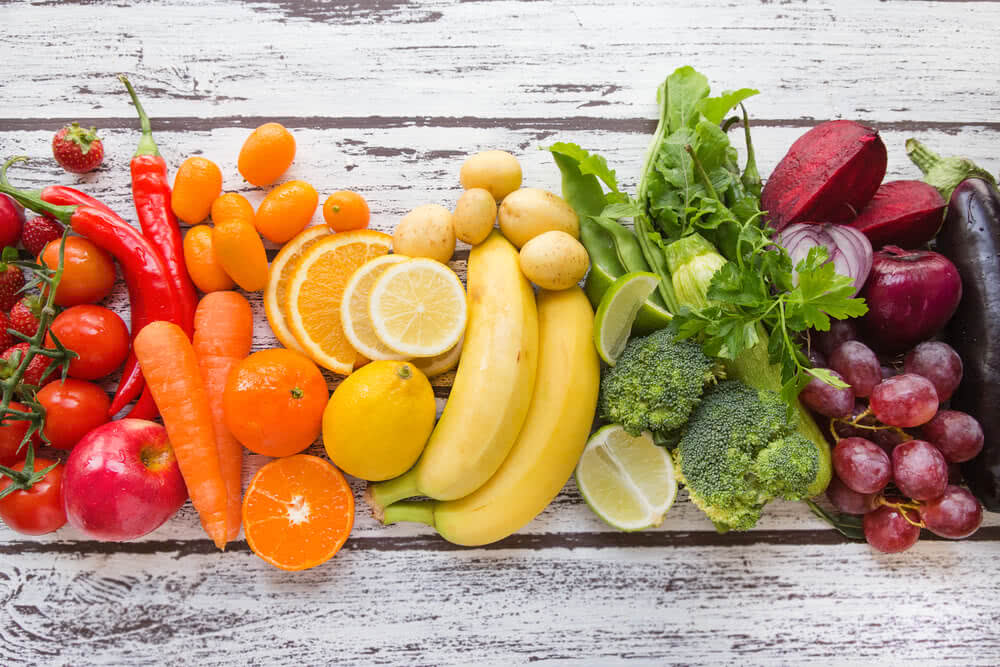
To prepare your "Rainbow diet plate," it is important to know what each color signifies and vegetables associated with it.
1. Red fruits and vegetables:
Vibrant Red color fruits and veggies contain phytochemicals viz. lycopene and anthocyanins. These phytochemicals are found only in plants and are known to reduce the risk of cancer, diabetes, and cardiovascular diseases. They are also known to improve skin quality, lower vision disorder and help the body get rid of free radicals.Red color fruits and vegetables that you can add to your diet:
- Raspberries - These are beneficial than the individual compounds consumed as dietary supplements.
- Red Pepper - Contains beneficial nutrients; enjoy it raw or cooked.
- Tomato - Tomato contains Lycopene, which is potent in cooked tomato products. Savor it as sauce or stew.
- Strawberries - Small strawberries contain less water and more nutrition. Thus, choose them over big ones.
- Watermelons - These are high in water content and continue to develop nutrients even after they have been picked.

2. Orange / Yellow fruits and vegetables:
The bright orange colored fruits and vegetables are packed with carotenoids, vitamins, and fiber. They safeguard the skin against the sun and pollution, improve immunity, protect vision, and promote healthy joints.
Orange / Yellow color fruits and vegetables that you can add to your diet:
- Orange - Eat the whole orange as the white substance between the peel and flesh (pith) is rich in fiber.
- Mangoes - The King of Fruits is rich in vitamins and minerals. It contains high levels of fructose; thus moderate consumption is advised.
- Boiled sweet potatoes - Sweet potatoes when boiled and consumed with the skin on, help in retaining vitamin C.
- Carrots - Carrots when boiled and consumed are known to retain 25 percent more of the cancer-fighting compound falcarinol.
- Lemons - These tangy fruits are a powerhouse of vitamin C, and when sprinkled on spinach are known to maximise the levels of iron.

3. Green fruits and vegetables:
Plants get their green color from Chlorophyll. The green plants are loaded with antioxidants, phytonutrients, and fiber. When consumed regularly the green veggies and fruits aid tissue healing, restore energy, increases vitality, detoxify, and provide digestive enzymes.
Green color fruits and vegetables that you can add to your diet:
- Broccoli - Leaves of this vegetable contain concentrated levels of nutrients.
- Kiwis - Kiwis contain enzymes that act as food tenderizers. Thus, while making a fruit salad, add kiwis the at the last minute.
- Spinach - Steamed spinach rather than the boiled one contains more nutrients.
- Zucchini - Garnish your pasta with spiraled zucchini and savor.
- Lettuce - Try using lettuce instead of bread wraps to cover your food.

4. Purple / Blue fruits and vegetables:
Blue and purple vegetables get their colors from anthocyanin and resveratrol. These distinctly colored edibles possess anti-aging and anti-inflammatory properties. They help in promoting longevity, reduce the risk of Alzheimer’s, boost the memory, protect cells from damage, and help in fighting inflammation.
Purple / Blue color fruits and vegetables that you can add to your diet:
- Blueberries - Raw blueberries contain valuable nutrients.
- Purple Cabbage - Purple cabbage, when sauteed and consumed, allows the body to retain nutrients.
- Plums - Raw plums contain the highest amount of vitamin c.
- Eggplant - Refrain from skinning the eggplant before cooking as its nutrition lies in the skin.
- Blackberries - Packed with wholesome health benefits, blackberries should be consumed in moderation as they contain a large amount of fructose. Read about 6 berries for healthy heart for a woman.

5. White fruits and vegetables:
We know technically white isn’t color of the rainbow. However, it promotes a broad range of health benefits. Anthoxanthins provide it the white hue, and they might also contain allicin and quercetin - beneficial phytonutrients.
White color fruits and vegetables that you can add to your diet:
- Cauliflower - Steamed cauliflower contains more nutrients than the boiled one.
- Raw Garlic - Raw garlic contains allicin - an antibacterial compound. Thus, consume it raw.
- Potatoes - After boiling, allow the potatoes to cool. This will allow the healthy resistant starch to form.
- Onions - Do not store potatoes and onions together as the onions absorb their moisture, and cause them to deteriorate faster.

Interesting, isn't it? Thus, next time you wish to grab and savor a rainbow, try creating a colorful vegetable or fruit plate.
Do you have any creative ideas of giving the body all the vitamins and minerals it desires? Let us know in the comments section below.
Eat Healthy. Live Healthy.












